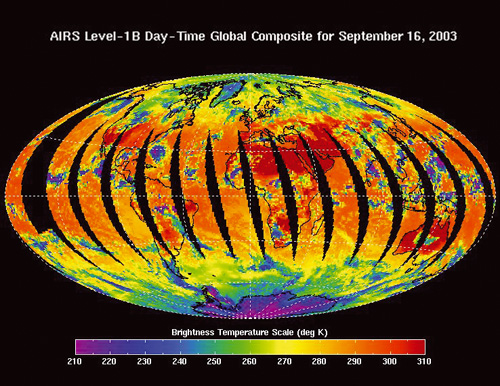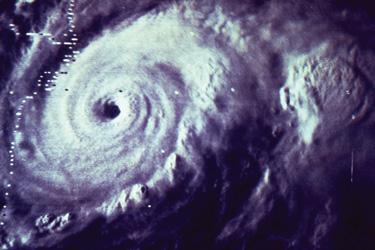Description
Atmospheric sounders generally make passive measurements of the distribution of IR or microwave radiation emitted by the atmosphere, from which vertical profiles of temperature and humidity through the atmosphere may be obtained. Oxygen or carbon dioxide is usually used as a ‘tracer’ for the estimation of temperature profiles since they are relatively uniformly distributed throughout the atmosphere, and hence atmospheric temperature sounders often measure radiation at wavelengths emitted by these gases. For humidity profiling, either IR or microwave wavelengths specific to water vapour are used. Most measurements are conducted in nadir viewing mode.
Sounders are able to estimate profiles of temperature and humidity by identifying radiation coming from different levels in the atmosphere. This is achieved by observations of the spectral broadening of an emission line, a phenomenon which is primarily caused by intermolecular collisions with other species, and which decreases with atmospheric pressure (and therefore is a function of altitude).
Microwave sounders have the ability to sound through cloud and hence offer nearly all-weather capability; their spatial resolution (both vertical and horizontal) is generally lower than that of the IR instruments. IR sounders are routinely used to provide temperature profiles from a few km altitude to the top of the atmosphere with a temperature accuracy of 2-3K, a vertical resolution of around 10km, and a horizontal resolution of between 10 and 100km.
The next generation of sounders, combining IR (IASI, CrIS) and MW (MHS, CMIS, ATMS) capabilities will feature: improved accuracy of humidity and temperature measurements (of order 10% accuracy for humidity and below 1K for temperature); better spatial resolution (to 1km); and improved capabilities in the upper atmosphere.
Observations of how the signals from Global Positioning Satellites (GPS) are affected as they travel through the atmosphere will be increasingly exploited using a technique known as GPS occultation. This technique is used to determine profiles of the pressure, temperature, and humidity and will provide complementary information.
Applications
Since the launch of the first weather satellites in the 1960’s, atmospheric sounders have provided valuable global observations of the atmosphere, even in the remotest areas. In 1969, the first temperature profile information estimated from satellite measurements was introduced into the Numerical Weather Prediction (NWP) models which are at the heart of daily weather forecasts; even in those early days the new satellite measurements improved forecasts significantly for many areas.
Today, atmospheric sounders are used to infer a wide range of key atmospheric parameters on an operational basis (mostly on polar orbiting satellites), and their data is used by NWP models in their raw form to such an extent that the satellite measurements are a vital and integral part of the global observing systems for operational meteorology. The same data is used on a longer term basis for studies of extended range weather and climate forecasting, and detection of climate change, including man-made climate change.
 Atmospheric sounders provide crucial inputs to weather forecasting systems |
 |
| Current & planned instruments AIRS AMSU-A AMSU-B ATMS CHAMP GPS Sounder CMIS CrIS Geomicrowave sounder GIFTS GOLPE GPS receiver GPSDR GRAS HIRS/2 HIRS/3 HIRS/4 HSB IASI IKFS-2 IMWTS IRAS ISAMS MASTER MHS MIPAS MIRAS MIVZA MLS MSU MTVZA MTVZA-OK MWHS MWR (BNSC) MWTS Radiomet ROSA SABER SAPHIR SMR Sounder Sounder (INSAT) SSM/T-1 SSM/T-2 SSMIS SSU TRSR |
| AMSU: amsu.cira.colostate.edu/ HIRS: www2.ncdc.noaa.gov/docs/klm/html/c3/sec3-2.htm NWP: www.metoffice.gov.uk/research/nwp/numerical/index.html Weather forecasting: www.usatoday.com/weather/wforcst0.htm GPS radio occultation: op.gfz-potsdam.de/champ/docs_CHAMP/GRL_2001_wickert.pdf |